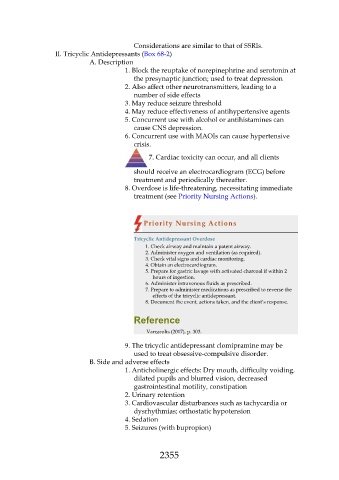Page 2355 - Saunders Comprehensive Review For NCLEX-RN
P. 2355
Considerations are similar to that of SSRIs.
II. Tricyclic Antidepressants (Box 68-2)
A. Description
1. Block the reuptake of norepinephrine and serotonin at
the presynaptic junction; used to treat depression
2. Also affect other neurotransmitters, leading to a
number of side effects
3. May reduce seizure threshold
4. May reduce effectiveness of antihypertensive agents
5. Concurrent use with alcohol or antihistamines can
cause CNS depression.
6. Concurrent use with MAOIs can cause hypertensive
crisis.
7. Cardiac toxicity can occur, and all clients
should receive an electrocardiogram (ECG) before
treatment and periodically thereafter.
8. Overdose is life-threatening, necessitating immediate
treatment (see Priority Nursing Actions).
Priority Nursing Actions
Tricyclic Antidepressant Overdose
1. Check airway and maintain a patent airway.
2. Administer oxygen and ventilation (as required).
3. Check vital signs and cardiac monitoring.
4. Obtain an electrocardiogram.
5. Prepare for gastric lavage with activated charcoal if within 2
hours of ingestion.
6. Administer intravenous fluids as prescribed.
7. Prepare to administer medications as prescribed to reverse the
effects of the tricyclic antidepressant.
8. Document the event, actions taken, and the client’s response.
Reference
Varcarolis (2017), p. 303.
9. The tricyclic antidepressant clomipramine may be
used to treat obsessive-compulsive disorder.
B. Side and adverse effects
1. Anticholinergic effects: Dry mouth, difficulty voiding,
dilated pupils and blurred vision, decreased
gastrointestinal motility, constipation
2. Urinary retention
3. Cardiovascular disturbances such as tachycardia or
dysrhythmias; orthostatic hypotension
4. Sedation
5. Seizures (with bupropion)
2355

